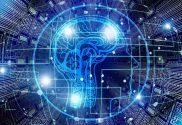
AI Trends of 2024: What developments can we expect next year?
Oh, the weather outside is frightful..but perhaps not as frightful as some of the artificial intelligence (AI) developments we’ve seen in 2023.
From creepy artistic robots to shockingly realistic news anchors, AI is here to stay and it’s developing at breakneck speed. But what about next year? What AI trends will 2024 have in store for us?
1. Generative AI and LLMs will start to noticeably change our lives
Think how much Generative AI and large language models (LLM) dominated the conversation surrounding AI in 2023. It all started when ChatGPT launched in November 2022 and has since snowballed. Now Google, Meta, Microsoft (through the OpenAI partnership), Amazon, and many more of Silicon Valley’s biggest companies are involved in gen AI.
It is likely to remain a dominant tech trend in 2024.
What the experts say
Christian Kleinerman, SVP of Product at Snowflake, a multi-billion dollar provider of cloud-based data storage, believes we have a lot of turmoil in store.
Writing in the company’s Data And AI Predictions 2024 Kleinerman says: “Lots of true disruption is coming. Mostly around end-user experience and how people interact with technology,” he says.
No one is arguing generative AI is a bubble that’s going to pop. There will be plenty of ‘.ai’ start-ups that can’t cut it in the long-term but the underlying technology is predicted to dramatically increase productivity in the workplace and enhance insights.
Kleinerman adds: “There’s a lot of opportunity to improve things in the business world, whether it’s around making individuals more productive or creating innovative end-user experiences and interactions. It will change roles, responsibilities, and skill sets.”
2. There will be growing pains as we adapt to AI proliferation
The internet has no shortage of those catastrophizing around what damage AI could do to humanity. The most extreme views predict it will wipe us out in some sort of Skynet-led Terminator-esque apocalypse. It’s right we consider the risks artificial intelligence poses, but a more grounded, realistic analysis finds the threats much less existential and more professional.
We cannot gloss over the fact there will be winners and losers from the development of this technology, particularly in the job market. If AI can help you do the work of multiple people, it doesn’t take long before a finance manager is going to ask themselves how necessary their current human staffing level is.
Customer service agents could be replaced by more advanced chatbots, financial services may see AI take on much of the predictive analysis and data crunching required, automated transportation will increase diminishing needs for human drivers, marketing will be bolstered by AI-generated messaging and many other industries will feel the pinch.
What the experts say
The world’s richest man, Elon Musk has spoken out frequently about the risks posed by AI.
“There will come a point where no job is needed,” the 52-year-old billionaire told the United Kingdom’s Prime Minister Rishi Sunak at a conference in November
“You can have a job if you want to have a job for personal satisfaction but no job is needed, the AI will able to do everything,” Musk said.
But the Tesla and Space X CEO said AI could be a great equalizer in society if we can meet the challenges it presents. While a time of universal income or “universal high income” as Musk calls it, is likely not going to be next year, expect to see some significant turbulence in the job market.
3. Advances in vision intelligence
Next year we will see significant strides in the ability of artificial intelligence systems to accurately perceive, interpret, and understand visual information such as digital images and videos. Essentially, AI will get better at ‘seeing’ images and multimedia.
Today, AI can tag people or objects in images, but it makes mistakes. Soon, it’ll name things correctly almost every time. Not only that – AI won’t just label stand-alone things. It’ll start noticing how objects fit together in a full scene and make sense of everything in one image. Like understanding a busy store with shelves, carts, and people is a grocery store. We will see systems able to identify peoples’ faces despite changes over time or blocked parts like glasses, and masks, which will assist law enforcement.
The applications of visual AI are extensive (and a tad dystopian). If AI gets better at seeing and understanding photos and videos it could help us catch broken equipment in factories automatically, guide self-driving cars efficiently, and identify from a scan if someone has a health condition.
Making “deepfake” photos and videos will keep getting easier. This is bad news but presumably, the tech to spot deepfakes will level up too. It’ll need to.
What the experts say
“AI could help inform decisions and better inform patients and providers about their individualized risks and benefits of certain surgeries,” said Christopher J. Tignanelli, MD a general surgeon and scientific director of the Program for Clinical AI at the University of Minnesota when discussing the application of AI to medicine.
4. Cybersecurity is going to become extra challenging
To put it mildly. Anyone who watched the recent Netflix film Leave The World Behind will have seen the terrifying effects of a massive, concerted nationwide cyberattack on the US. Granted, it’s fiction, but genuine cyberattacks at scale have the potential to cause serious damage.
AI developments are moving at such whirlwind speeds in their capabilities that it will be a battle for security specialists to keep up. Unfortunately, cybercriminals will initially benefit more from generative AI than defenders, making existing attacks like phishing and social engineering more effective.
There are also risks around misinformation. The effects of a bad actor undertaking a significant propaganda operation in which political content is planted that clouds the truth about a nation-state conflict, election integrity, or a political candidate are not hard to imagine. For years social media bots have been used to influence mainstream opinion and talking points, with AI advancements these techniques will become more sophisticated.
What the experts say
“Legitimate businesses are careful about adopting and using new technologies—there’s cost, regulatory requirements, and reputational risk if it’s done poorly,” says Mario Duarte, Snowflake’s VP of Security.
“Bad guys won’t wait. So at first, they’ll have the full firepower of LLMs and gen AI, and defenders will be playing catch-up.”
Eventually, he says, the playing field will even out. But expect a lot of pain in the meantime.
5. Governments move to legislate
The remarkable journey of artificial intelligence has now become a subject of paramount concern for policymakers worldwide. As we approach 2024, prominent nations like China, the European Union, the United States, and India are painstakingly crafting extensive AI policies.
These initiatives have a threefold purpose: to stimulate groundbreaking technological advancements, attract global investments, and simultaneously protect their citizens from any unintended consequences of AI. Discussions within the industry are hinting at the possibility of international cooperation in establishing AI standards and guidelines, suggesting that collaborative efforts on a global scale in this realm may soon become a reality.
What the experts say
The founder of Microsoft Bill Gates is a proponent of regulation in the AI space.
In September, Gates said: “The potential of AI is limitless — but we will only realize that potential if government, the private sector, and civil society work together to maximize the technology’s benefits and minimize its risks.”
Featured image: AI-generated image from DALL-E




